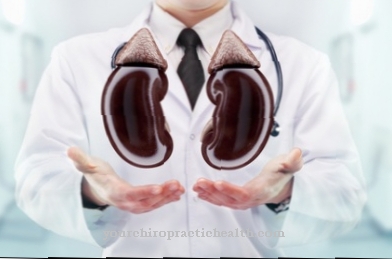In the Tension band osteosynthesis it is a surgical procedure for the reduction and fixation of displaced fractures that run through joints. This is a frequently used and reliable method in the field of surgical and orthopedic care.
What is tension band osteosynthesis?

Tension band osteosynthesis is a procedure from the area of internal fixation of special fracture fragments by foreign material. The basis of the tension band osteosynthesis comes from engineers in reinforced concrete construction. The effect of this technique was scientifically substantiated by Friedrich Pauwels and the concept of the procedure was then presented for the first time in 1958 and carried out by orthopedists and surgeons.
The tension belt osteosynthesis is used in the field of surgery and orthopedics. Fractures (broken bones) that run in the area of a joint and the fracture fragments (fragments) are removed from each other by the tensile force of a tendon are treated. These fractures are treated with a wire loop under tension. The point here is that the fragments are anchored together until they have grown together again. Such fractures are usually caused by falls or direct external forces on the bone.
In combination with increased muscle tension, this can lead to a tendon tearing out. The increased muscle tension arises reflexively, e.g. in the event of a fall, for self-protection in order to catch yourself if possible.
Function, effect & goals
If a fracture occurs as a result of trauma, the following properties are decisive in order to treat it using tension band osteosynthesis.The fracture is in the area of a joint and may affect parts of the articular surface.
A torn partial fragment is under the tension of a muscle that is connected to the fragment by a tendon. The fragments are dislocated and thus distanced from one another by the tensile force of the tendon. If these properties are given in a fracture, the fracture is surgically treated with spike wires or Kirschner wires and wire loops. The wires mostly consist of chrome-cobalt-molybdenum alloys, surgical steel or titanium alloys.
Typical fractures of this type are, for example, the olecranon fracture (elbow joint) and a fracture of the patella (kneecap). But also fractures in the area of the malleoli (inner and outer ankles on the foot) of the upper ankle joint or bony tears in the area of the metatarsus are treated with a tension strap osteosynthesis. These are fixed with wire loops, but not under tension.
If a fracture with dislocated fracture fragments is surgically treated with tension band osteosynthesis, the surgeon must first align all fracture fragments with one another in order to restore the anatomical shape and thus the axis-correct function of the joint. The spike wires or Kirschner wires must then be inserted as parallel to one another as possible in order to avoid blocking the joint function. Beginning in the area of the tendon attachment, the spike wires are inserted and run vertically through the course of the fracture in the immediate vicinity of the joint surface. The surgeon must ensure that the wires do not perforate the tissue. The wires are not inserted using imaging techniques. The surgeon orientates himself by palpation on the joint structures.
Once the spike wires have been attached, their ends are bent over and firmly anchored in the opposite cortex. An imaging control can then confirm the correct position.
By attaching the wire cerclage, an even tension is now applied to the spike wires and ensures that the fracture fragments do not move away from each other even when the muscles are tensed. The wire loop is fixed by twisting the helix in different directions. The resulting wire vortices are shortened to 7-10mm at the end with pliers. The wire ends of the spike wires are shortened to 5-7mm and bent by about 90 °. Finally, the affected joint is fully functional under the anesthetic in order to rule out functional disorders. A final X-ray check shows the position and course of the wires again. If the wires are in the right place and the joint can move freely, the operation has been successful.
A Redon drain is placed proximal to the treated fracture to suck out fluid and blood. A sterile and dry bandage is applied with slight compression. On the first postoperative day, light physiotherapeutic movement exercises can usually be started in a pain-oriented manner. On the second postoperative day, the Redon drain is removed.
The clear advantage of tension band osteosynthesis is the reliable result and the low cost of the material. In addition, the patient can move the affected extremity freely postoperatively and can thus prevent risks such as thrombosis or muscle atrophy.
Risks, side effects & dangers
After the inpatient discharge from the hospital, further treatment and regular control by a specialist should take place. What is important here is complete wound control, thread tension after approx. 14 days, x-ray control after 4 and 8 weeks and intensive physiotherapeutic movement exercises.
The following risks should always be weighed despite the reliable and often used method. Every treatment with an osteosynthesis procedure of this kind is associated with an operation and therefore anesthesia. Especially in geriatric patients, swallowing difficulties, cardiovascular problems or breathing disorders can occur. Material removal is therefore no longer undertaken in older patients and kept as minimally invasive as possible in younger patients. Side effects such as wound healing disorders, pain, infections and functional restrictions can occur postoperatively.
Furthermore, overloading or material failure can lead to loosening or breakage of the wires. This should be recognized and treated again as quickly as possible with regular check-ups by imaging methods, since the fracture fragments can shift and the joint may be misaligned. If the fracture fragments grow together in a misalignment, permanent impairment and discomfort can occur.













.jpg)

.jpg)
.jpg)











.jpg)